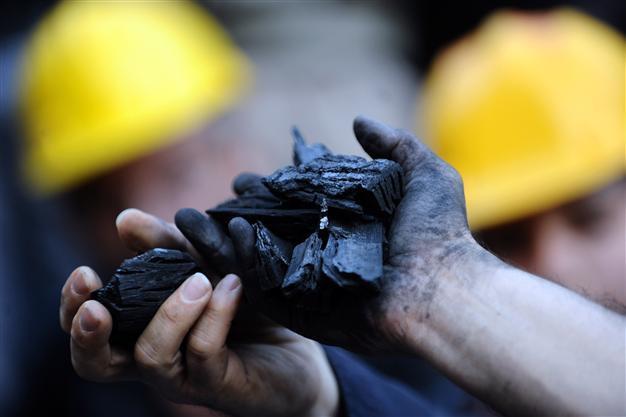Coal & bread
Aylin ÖNEY TAN

Protestors hold coal in their hands during a demonstration for the victims of the Soma mine accident on May 15, 2014, near Taksim Square in Istanbul. AFP Photo / Ozan KÖSE
The history of mining is full of agony. Thank God our PM reminded us that we’re not alone. As if that was the sole answer to how the terrible accident happened, he proudly gave a chronicle of the worst mining disasters throughout history with casualties rivaling the recent Soma tragedy, saying such things just happen! I remained mortified listening to this so out-of-context speech, but I must admit it reminded me that remembering history has its merits every now and then.The list started with the awful explosion that killed 388 miners in Oaks Mine in South Yorkshire in 1886. So far, that was the second deadliest mining disaster in the United Kingdom after the accident at Senghenydd Colliery in 1913 with 439 deaths. Both accidents are marked as milestones of mining tragedies, but there is more to the details. The Oaks incident ignited the proletariat movement, and eventually inspired Karl Marx in writing “Das Kapital.” Comparing pre-revolutionary wild capitalism days to today’s economic scene in Turkey is spot on, but giving examples from the pre-technology era of 150 years ago in the 21st century is a bit unfortunate. However we see no big differences in the circumstances of Turkish coal miners when compared to the living standards of miners of 19th century England. Bread winning is hard for miners, and all they gain is restricted to a loaf bread and a few black olives, dark as pebbles of coal. If we look at the food provisions of the miners in Soma, it is hard to believe that there is none. The miners were forced to work every single day, and they had to bring their own food from home. Their table was a makeshift counter made from two planks of wood; all they had could be as little as some bread with a few flavor enhancers like onions and olives or homemade gözleme, a flat dough roll. If we look at the history of food of miners in the United Kingdom, we see that the food they had was much more sophisticated if we consider the infamous Cornish pasty.
The Cornish pasty is a kind of D-shaped folded pie filled with meat and vegetables. What to put in a Cornish pasty is open to an endless debate. One thing is certain: The meat has to be raw, not minced but hand chopped. Some put carrots, celery etc., some are horrified by this idea. The authentic seems to be made from venison but then the humble pie was not a provision of the working classes, but rather a royal dish fit for hunting feasts. The classic Cornish pasty usually contains beef, potatoes, swede (called turnips in Cornwall) and onions, all chopped roughly and filled into the pastry case raw. There can be meatless vegetarian versions or sweet pasties filled with jam or fruits. A typical miner’s pasty could even have both savory and sweet fillings, fulfilling the appetite and nutritional need of hard workers.
The pasty became popular during the 17th and 18th centuries with the working communities of Cornwall, known for its tin and copper mining industry. The dough encased rich fillings provided a wholesome lunch for miners who adopted the pasty due to its unique shape that could easily be carried, held in hand and eaten without cutlery. The dense folded pastry could keep the filling warm for several hours, and if split open, one side of the dough would serve as an edible plate from which the filling could be eaten scraped with another piece of dough. However, it was way easier to hold the hearty pasty from the hard crimped sides or corners. Sometimes one corner was marked by the initials of the miner so that any remains of a pasty not finished in one go could be reclaimed by the owner to be consumed later.
According to the earliest Cornish recipe book “Cornish Recipes Ancient and Modern” published in 1929, the correct fashion to eat a pasty is described as such: “The true Cornish way to eat a pasty is to hold it in the hand, and begin to bite it from the opposite end to the initial, so that, should any of it be uneaten, it may be consumed later by its rightful owner. And woe betide anyone who takes another person’s corner!”
It was true that the Cornish miners believed that the initial corner should never be eaten. There could have been some truth to this rumor, because the early Cornish tin mines had large amounts of arsenic, so it was wise to avoid eating the arsenic contaminated thick edge or corner that the miner held. They had a superstition to drop that bit on the ground for the mining gremlins to eat. It was those “gremlins” that caused accidents, blasts and mine collapses, so it was better to feed them as to not have their mischief.
Oh, there is the history lesson! How I wish our Turkish miners had such superstitions and believed in mine gremlins. As the prime minister has put it, there is only one to blame: It was all fate, the will of God! It would be fantastic if the miners of Soma had dropped a few crumpets of their hard earned bread to feed the evil forces. Instead, they kept feeding the insatiable appetite of politicians and patrons, not with crumpets, but with their blood, sweat and tears!












